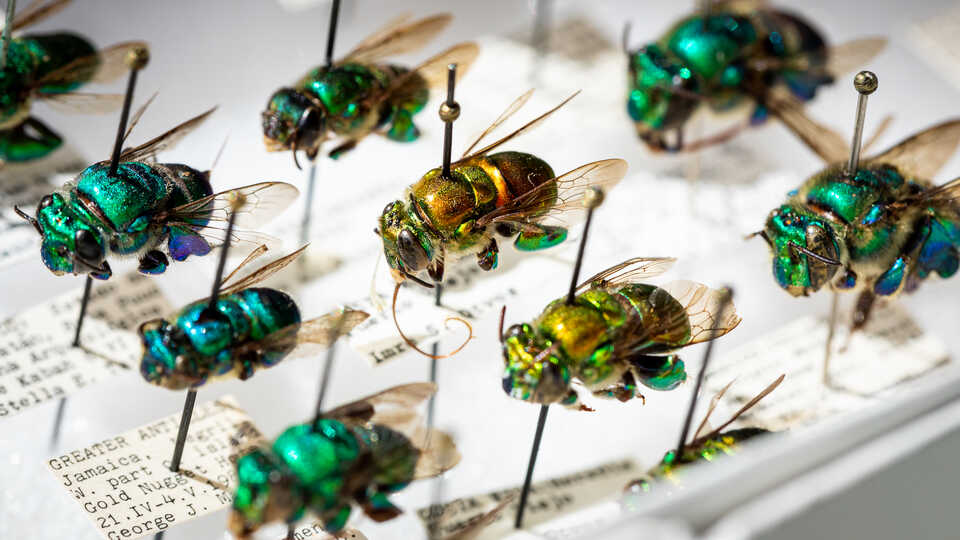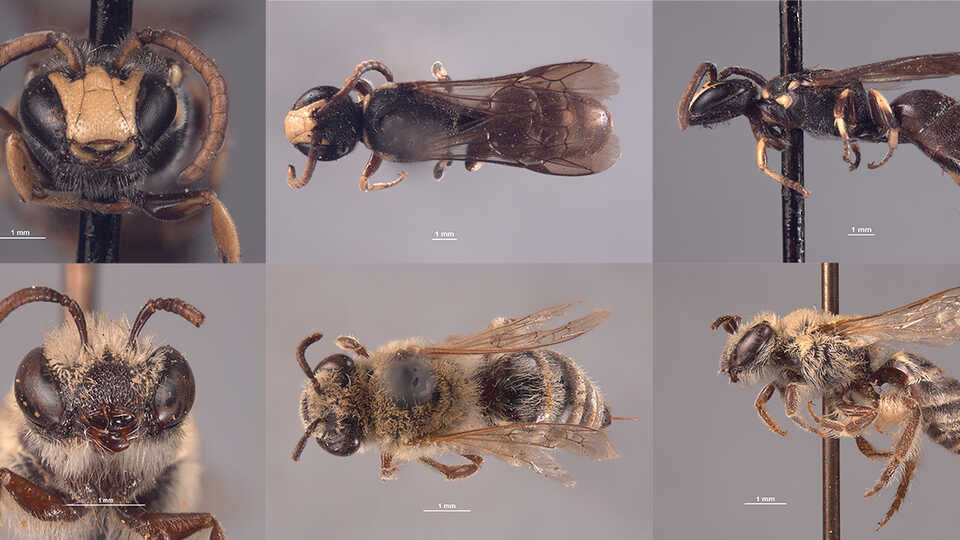The California Academy of Sciences is a renowned scientific and educational institution with a mission to regenerate the natural world through science, learning, and collaboration. Based in San Francisco’s Golden Gate Park, it is home to a world-class aquarium, planetarium, and natural history museum, as well as innovative programs in scientific research and environmental education—all under one living roof. Museum hours are 9:30 am – 5:00 pm Monday – Saturday, and 11:00 am – 5:00 pm on Sunday. Admission includes all exhibits, programs, and shows. For daily ticket prices, please visit www.calacademy.org or call (415) 379-8000 for more information.
Award is part of a multimillion dollar NSF-funded project that will result in—and provide equitable access to—the world’s largest dataset on bees
SAN FRANCISCO, CA (October 28, 2021) — The California Academy of Sciences has been awarded a $255,400 grant to generate high-resolution images of nearly all of the roughly 180,000 individual bee specimens housed in the Academy’s scientific collections. The grant is part of a 3-year, $3.1 million National Science Foundation-funded Advancing Digitization of Biodiversity Collections project called Big-Bee that will result in the digitization of more than half a million bee specimens representing more than 5,500 species—a quarter of all known species—from scientific institutions across the country. All of the data generated will be made freely available online, empowering researchers around the world to make new discoveries about how bee populations have changed over time—and what threats might be driving those changes.
“With this grant, we will be able to unlock and democratize the power of our bee collection,” says Academy Collections Manager Christopher Grinter. “Our specimens provide important snapshots of bee populations from locations around the world going as far back as 150 years ago, providing an important baseline for better understanding the decline of bees today.”
Though bees are among the world’s most ecologically and economically important animals, pollinating around 75 percent of all fruits and vegetables grown in the United States along with 80 percent of all flowering plants, the drivers behind their current widespread population declines remain murky, partially due to a lack of data on historical populations.
Just like knowing the background and historical context for a piece of art can give it deeper meaning, comparing historical populations of bees to those found today can give researchers a better understanding of how changes in the surrounding environment may have factored into population declines.
“Having a solid picture of all the specimens in our collection will open up whole new avenues for bee research,” Grinter says.
To determine what data would be most useful, University of California, Santa Barbara bee researcher and Big-Bee project lead Katja Seltmann, PhD, convened stakeholders from more than a dozen partner institutions and federal agencies, including the University of California, Berkeley, the Natural History Museum of Los Angeles County, and the U.S. Geological Survey.
As a result, information about where and when a specimen was collected will be supplemented with over a million high-resolution 2D and 3D images that will allow researchers to analyze morphology, anatomy, and other traits of the bees.
“A bee’s anatomy can change in response to its environment,” Seltmann says. “By studying these images, researchers like myself will be able to infer the health of the environment over time and measure how resilient different bee species and populations are to stressors like climate change or habitat loss.”
Currently, when researchers are interested in studying the biodiversity of bees they are often left to trawling individual collections to create their own workable datasets. That data, however, is rarely made publicly available leaving the next interested research team to develop their own datasets as well.
“Through Big-Bee, we will prevent researchers from having to recreate the wheel over and over again with these datasets by instead making them readily available,” Seltmann says. “In doing so, we will enable bee science to move forward and empower researchers to build on each other’s work.”
By making all of the data generated from the Big Bee project open access, researchers, educators, artists, and anyone else that might be interested in high-resolution images of bees—and the information or inspiration they hold—can use them.
“As one of the largest and best-funded institutions in the world, we have a responsibility to researchers, particularly those from developing countries from which many of these bees were originally taken, and to the animals themselves, which were collected for science, to make this data freely accessible to the global research community,” Grinter says.
Over the course of the three-year project, the Academy’s grant will also fund an annual paid internship for early-career scientists or undergraduate students from underrepresented groups to gain experience in scientific research and museum curation.
“We’re excited to have this opportunity to increase equity in who gets to participate in scientific research,” Grinter adds, “both around the world and in our own backyard."
The Institute for Biodiversity Science and Sustainability at the California Academy of Sciences is at the forefront of efforts to regenerate the natural world through science, learning, and collaboration. Based in San Francisco, the Institute is home to more than 100 world-class scientists, state-of-the-art facilities, and nearly 46 million scientific specimens from around the world. The Institute also leverages the expertise and efforts of more than 100 international Associates and 450 distinguished Fellows. Through expeditions around the globe, investigations in the lab, and analysis of vast biological datasets, the Institute’s scientists work to understand the evolution and interconnectedness of organisms and ecosystems, the threats they face around the world, and the most effective strategies for ensuring they thrive into the future. Through deeply collaborative partnerships and innovative public engagement initiatives, they also guide critical conservation decisions worldwide, inspire and mentor the next generation of scientists, and foster responsible stewardship of our planet.
Press Contacts
If you are a journalist and would like to receive Academy press releases please contact press@calacademy.org.
Digital Assets
Hi-res and low-res image downloads are available for editorial use. Contact us at press@calacademy.org to request access.


